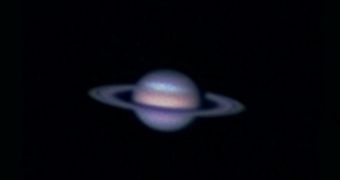In mid-December 2010, astronomers reported the development of a massive storm in the atmosphere of the gas giant Saturn, one of the largest planets in our solar system. The atmospheric structure has since grown to impressive size, reaching a diameter more than ten times that of Earth's.
Last year, the beginning of the storm was imaged by the suite of scientific instrument aboard the Cassini orbiter, a NASA spacecraft that has been surveying the planet since July 1, 2004.
The probe produced interesting images of the white scar that the storm produced on Saturn's face, and also measured several key features the atmospheric front had. Now, about a month later, readings show that the size of this storm is continuing to grow.
These changes were observed both by professional and amateur astronomers. The latter tend to conduct their observations in much worse conditions than their professional colleagues.
“I was out from 4:30am to 6:00am early Saturday morning. I brushed all the snow off my Dome, and spent an hour or so shooting Saturn with its Big White Storm brewing in the cloud tops.” explains Dayton, Ohio-based enthusiast John Chumack.
“The seeing conditions were not the best, but I went for it anyway, after the high cirrus clouds moved out of the way, I had to try! -3F Temps in my backyard in Dayton, OH nearly killed my attempt,” he goes on to say, quoted by Universe Today.
“The storm is enormous. It’s no wonder we can see it from Earth, since Saturn at the time of this shot was about 865.2 million miles away or 1.392 billion kilometers from us!” Chumack explains.
The Saturnine atmosphere is really quite chilly, at average levels of -218.47 to -308.47 degrees Fahrenheit. The actual temperature depends entirely on the depth at which the measurements are being made. Due to these conditions, a large number of hurricane-like storms develop on Saturn.
Although Cassini is observing the structure, it has yet to deliver the relevant images that depict the phenomenon in detail. The NASA mission is managed by the Jet Propulsion Laboratory (JPL), in Pasadena, California.
Since it arrived at Saturn, the spacecraft has been conducting studies of the planet, its atmosphere and magnetic field, its rings systems and its moons. These researches have advanced our knowledge of the solar system considerably.
Understanding storms here is key to gaining a deeper insight into why they form on other gas giants, such as Jupiter, experts say.

 14 DAY TRIAL //
14 DAY TRIAL //